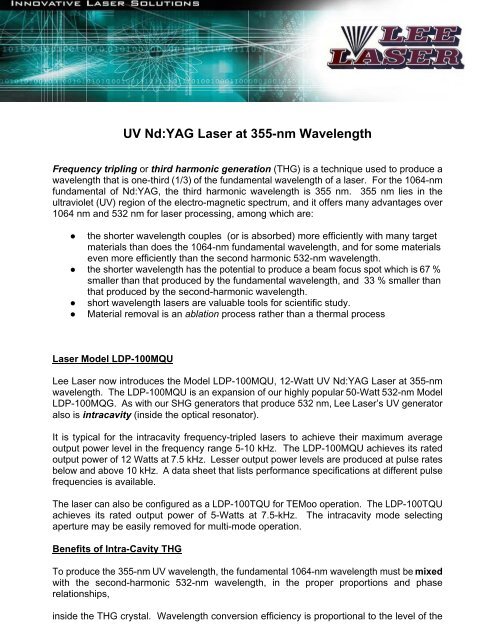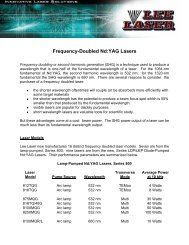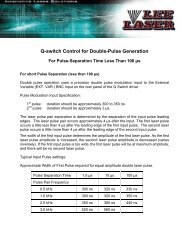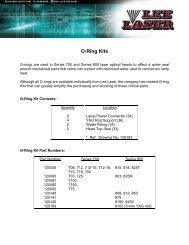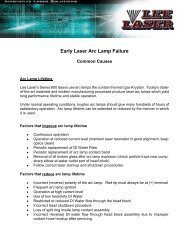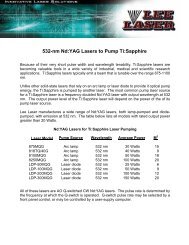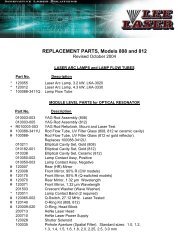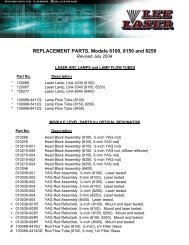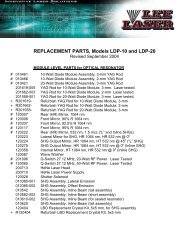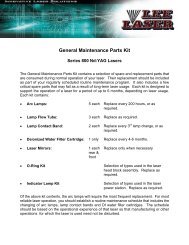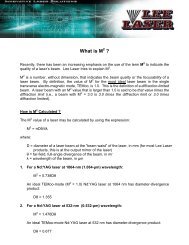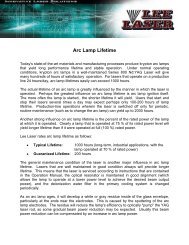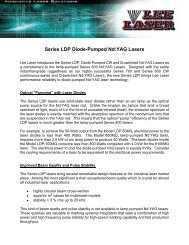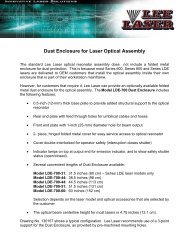UV Nd:YAG Laser at 355-nm Wavelength - Lee Laser, Inc.
UV Nd:YAG Laser at 355-nm Wavelength - Lee Laser, Inc.
UV Nd:YAG Laser at 355-nm Wavelength - Lee Laser, Inc.
Create successful ePaper yourself
Turn your PDF publications into a flip-book with our unique Google optimized e-Paper software.
<strong>UV</strong> <strong>Nd</strong>:<strong>YAG</strong> <strong>Laser</strong> <strong>at</strong> <strong>355</strong>-<strong>nm</strong> <strong>Wavelength</strong>Frequency tripling or third harmonic gener<strong>at</strong>ion (THG) is a technique used to produce awavelength th<strong>at</strong> is one-third (1/3) of the fundamental wavelength of a laser. For the 1064-<strong>nm</strong>fundamental of <strong>Nd</strong>:<strong>YAG</strong>, the third harmonic wavelength is <strong>355</strong> <strong>nm</strong>. <strong>355</strong> <strong>nm</strong> lies in theultraviolet (<strong>UV</strong>) region of the electro-magnetic spectrum, and it offers many advantages over1064 <strong>nm</strong> and 532 <strong>nm</strong> for laser processing, among which are:the shorter wavelength couples (or is absorbed) more efficiently with many targetm<strong>at</strong>erials than does the 1064-<strong>nm</strong> fundamental wavelength, and for some m<strong>at</strong>erialseven more efficiently than the second harmonic 532-<strong>nm</strong> wavelength.the shorter wavelength has the potential to produce a beam focus spot which is 67 %smaller than th<strong>at</strong> produced by the fundamental wavelength, and 33 % smaller thanth<strong>at</strong> produced by the second-harmonic wavelength.short wavelength lasers are valuable tools for scientific study.M<strong>at</strong>erial removal is an abl<strong>at</strong>ion process r<strong>at</strong>her than a thermal process<strong>Laser</strong> Model LDP-100MQU<strong>Lee</strong> <strong>Laser</strong> now introduces the Model LDP-100MQU, 12-W<strong>at</strong>t <strong>UV</strong> <strong>Nd</strong>:<strong>YAG</strong> <strong>Laser</strong> <strong>at</strong> <strong>355</strong>-<strong>nm</strong>wavelength. The LDP-100MQU is an expansion of our highly popular 50-W<strong>at</strong>t 532-<strong>nm</strong> ModelLDP-100MQG. As with our SHG gener<strong>at</strong>ors th<strong>at</strong> produce 532 <strong>nm</strong>, <strong>Lee</strong> <strong>Laser</strong> s <strong>UV</strong> gener<strong>at</strong>oralso is intracavity (inside the optical reson<strong>at</strong>or).It is typical for the intracavity frequency-tripled lasers to achieve their maximum averageoutput power level in the frequency range 5-10 kHz. The LDP-100MQU achieves its r<strong>at</strong>edoutput power of 12 W<strong>at</strong>ts <strong>at</strong> 7.5 kHz. Lesser output power levels are produced <strong>at</strong> pulse r<strong>at</strong>esbelow and above 10 kHz. A d<strong>at</strong>a sheet th<strong>at</strong> lists performance specific<strong>at</strong>ions <strong>at</strong> different pulsefrequencies is available.The laser can also be configured as a LDP-100TQU for TEMoo oper<strong>at</strong>ion. The LDP-100TQUachieves its r<strong>at</strong>ed output power of 5-W<strong>at</strong>ts <strong>at</strong> 7.5-kHz. The intracavity mode selectingaperture may be easily removed for multi-mode oper<strong>at</strong>ion.Benefits of Intra-Cavity THGTo produce the <strong>355</strong>-<strong>nm</strong> <strong>UV</strong> wavelength, the fundamental 1064-<strong>nm</strong> wavelength must be mixedwith the second-harmonic 532-<strong>nm</strong> wavelength, in the proper proportions and phaserel<strong>at</strong>ionships,inside the THG crystal. <strong>Wavelength</strong> conversion efficiency is proportional to the level of the
3LBO SHG and THG Crystals<strong>Lee</strong> <strong>Laser</strong> uses LBO (lithium tribor<strong>at</strong>e) as its choice of all harmonic gener<strong>at</strong>or crystals. LBO isas much as seven (7) times more durable than KTP (potassium titanyl phosph<strong>at</strong>e) againstinternal, bulk damage from laser beam propag<strong>at</strong>ion. The crystals are housed insidetemper<strong>at</strong>ure controlled ovens th<strong>at</strong> maintain an elev<strong>at</strong>ed, but near-room temper<strong>at</strong>ure within0.1 o C. Precise temper<strong>at</strong>ure control of the LBO crystal is vital to maintain a stable levelof output beam power.SHG/THG Crystal Protection from <strong>Laser</strong> DamageTo provide maximum protection against optical damage, <strong>Lee</strong> <strong>Laser</strong> uses only opticalcomponents th<strong>at</strong> have the gre<strong>at</strong>est damage resistance th<strong>at</strong> are commercially available. Weavoid inferior optics th<strong>at</strong> now are available in large quantities <strong>at</strong> very low prices, but which weknow will not provide long-term reliable performance.In a THG optical reson<strong>at</strong>or, it is the SHG and THG crystals themselves th<strong>at</strong> are the mostsensitive to laser damage. This damage can be caused by airborne contamin<strong>at</strong>ion th<strong>at</strong> hasbeen allowed to settle on the optical surfaces. SHG and THG crystal damage may also becaused from oper<strong>at</strong>ion of the laser in a low-pulse-r<strong>at</strong>e mode in which the high pulse energyand short pulse width combine to gener<strong>at</strong>e a high peak pulse power condition. To avoid SHGcrystal and AR co<strong>at</strong>ing damage, <strong>Lee</strong> <strong>Laser</strong> recommends against oper<strong>at</strong>ion <strong>at</strong> pulse r<strong>at</strong>es (Qswitchfrequencies) below 5 kHz, unless the laser has been specifically configured by <strong>Lee</strong><strong>Laser</strong> to do so.A special design fe<strong>at</strong>ure of all <strong>Lee</strong> <strong>Laser</strong> Q-switched products also helps to protect the SHGand THG crystals from laser damage. Pulse Quench is a technique used by <strong>Lee</strong> <strong>Laser</strong> tosuppress the high pulse energy and peak pulse power th<strong>at</strong> is characteristic of the first giantpulse in a g<strong>at</strong>ed series of Q-switch pulses (ref. technical bulletin, Pulse Quench: <strong>Lee</strong> <strong>Laser</strong>First Pulse Suppression). For <strong>UV</strong> lasers, the giant first pulse can cause prem<strong>at</strong>ure damageto the SHG and THG crystals. The suppression of this first pulse by Pulse Quench gre<strong>at</strong>lyextends the useful lifetime of the crystals.


